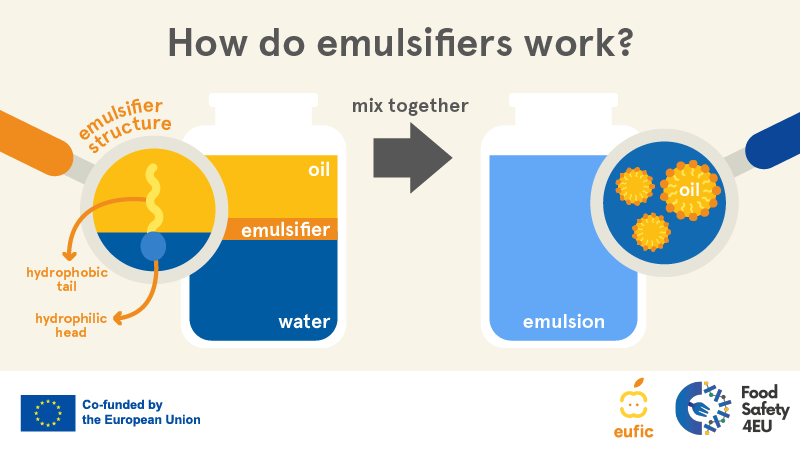10 Factors Why Emulsifier In Food Boosts Smoothness and Freshness
Learn Just How an Emulsifier in Food Can Help Achieve Completely Blended Recipes Each Time
Emulsifiers are vital components in the culinary globe, allowing the blending of oil and water-based components. Their capacity to decrease surface area tension allows for the development of secure mixes, improving both texture and taste in numerous dishes. Comprehending how these compounds function can transform the method one approaches food preparation. Lots of remain not aware of the various kinds of emulsifiers and their details applications. Exploring this subject discloses important understandings for achieving cooking excellence.
What Are Emulsifiers and How Do They Function?
Emulsifiers play a vital role in the food market by enabling the steady blending of ingredients that typically do not combine, such as oil and water. These materials possess both hydrophilic (water-attracting) and hydrophobic (water-repelling) residential or commercial properties, permitting them to interact with both kinds of active ingredients. When an emulsifier is contributed to a combination, it decreases the surface tension between the oil and water, facilitating the formation of small droplets of one fluid distributed within the other. This procedure creates a stable solution, avoiding splitting up with time and enhancing texture and mouthfeel. Emulsifiers are essential in different food items, from salad dressings to gelato, ensuring consistency and quality. They likewise add to the general sensory experience of food, influencing flavor release and aesthetic allure. Recognizing just how emulsifiers operate is vital for food researchers and cooks alike, as they seek to develop enjoyable and balanced culinary experiences.
Usual Types of Emulsifiers Made Use Of in Food Preparation
Numerous types of emulsifiers are utilized in food preparation to accomplish preferred appearances and stability in various food. Common emulsifiers consist of lecithin, which is naturally located in egg yolks and soybeans, and is commonly used in mayonnaise and dressings. An additional prevalent emulsifier is mustard, which contains substances that help mix oil and water in sauces.
In addition, commercial emulsifiers such as mono- and diglycerides are often contributed to refined foods to enhance their security and improve shelf life. Starch-based emulsifiers, stemmed from corn or potatoes, are likewise used in gravies and desserts for enlarging and appearance. Casein, a milk protein, offers as an emulsifying agent in dairy products like cheese and lotion. Each of these emulsifiers plays a crucial duty in making sure that ingredients blend flawlessly, offering the preferred uniformity and taste in culinary creations.
The Scientific research Behind Emulsification

The stability of a solution counts on the balance between the pressures acting on the spread droplets. If the beads integrate, the emulsion can break, leading to separation. Numerous elements, such as temperature, concentration of the emulsifier, and the approach of blending, influence the success of emulsification. Understanding this clinical structure is necessary for accomplishing constant outcomes in culinary applications entailing solutions.
Tips for Making Use Of Emulsifiers in Your Recipes
When incorporating emulsifiers right into recipes, careful consideration of their buildings and capability can substantially improve the end product. Initially, one need to choose the proper emulsifier based on the wanted structure and security of the meal. Emulsifier In Food. Usual choices include egg, lecithin, and mustard yolks, each offering special advantages
It's necessary to recognize the temperature level at which the emulsifier functions best; as an example, some emulsifiers function successfully at room temperature level, while others call for warm. Gradually adding oil to the emulsifier while whisking can assist create a secure emulsion.
Furthermore, the ratio of emulsifier to liquid is essential; inadequate might result in splitting up, while excessive can create an unwanted texture. Correct storage conditions ought to be taken into consideration, as some emulsified items may require refrigeration to maintain stability and quality. By following these tips, cooks can accomplish continually well-blended dishes.

Delicious Recipes Featuring Emulsifiers
While many cooks may not understand it, including emulsifiers right into recipes can raise meals to new heights of flavor and appearance. As an example, a classic vinaigrette advantages greatly from the enhancement of mustard, which works as an emulsifier, offering a smooth uniformity that binds oil and vinegar seamlessly. Similarly, homemade mayo showcases the power of egg yolks, producing a creamy, luxurious sauce excellent for salads and sandwiches.
In baking, emulsifiers like lecithin can help attain a tender crumb in cakes and muffins, boosting wetness retention. An abundant chocolate ganache, made with hefty cream and chocolate, can additionally integrate an emulsifier to maintain a silky coating. In addition, gelato usually utilize emulsifiers to assure a creamy structure and avoid ice crystal development, resulting in a fascinating treat a fantastic read experience. By integrating these emulsifying representatives, chefs can create recipes that thrill the palate and supply a satisfying mouthfeel.
Often Asked Inquiries
Are Emulsifiers Safe for People With Food Allergies?
Emulsifiers can be secure for individuals with food allergies, relying on the specific emulsifier utilized. Cross-reactivity and private sensitivities vary; subsequently, speaking with a health care expert is recommended to ensure safety.
Can I Make My Own Emulsifier in the house?
Yes, individuals can develop homemade emulsifiers making use of components like egg yolks, mustard, or honey. These natural alternatives can efficiently blend oils and water-based components, providing a basic remedy for different culinary applications.
Exactly How Do Emulsifiers Affect the Nutritional Worth of Food?
Emulsifiers can improve the nutritional value of food by improving nutrient absorption and stability. However, too much intake might cause unfavorable effects, potentially altering digestion processes and impacting gut wellness in delicate individuals.


Exist Any Type Of Negative Negative Effects of Consuming Emulsifiers?
Some research studies recommend that consuming emulsifiers might bring about stomach problems or interfere with gut microbiota equilibrium. However, additional study is required to fully understand their lasting impacts on health and possible unfavorable side effects.
Can Emulsifiers Modification the Flavor of My Recipes?
Emulsifiers can discreetly modify the flavor account of recipes. By improving appearance and mouthfeel, they might make flavors much more well balanced or obvious, but they generally do not impart strong tastes on their very own.
Emulsifiers play a vital role in the food market by making it possible for the stable mixing of ingredients that web generally do not incorporate, such as oil and water. Various types of emulsifiers are made use of in food preparation to achieve wanted appearances and security in various food products. In addition, industrial emulsifiers such as mono- and diglycerides are usually included to refined foods to improve their stability and boost shelf life. It's essential to recognize the temperature at which the emulsifier operates finest; for instance, some emulsifiers function successfully at room temperature, while others require warmth (Emulsifier In Food). Emulsifiers More Help can be safe for individuals with food allergic reactions, depending on the particular emulsifier made use of